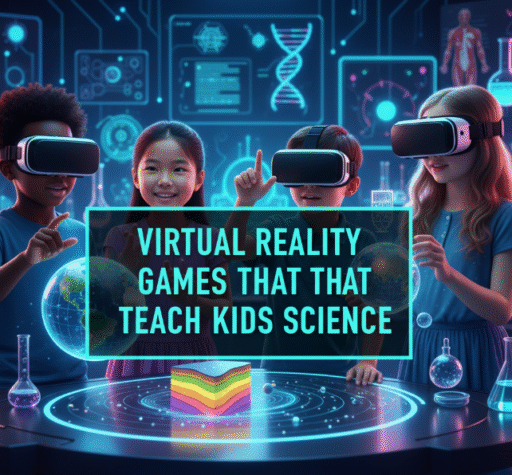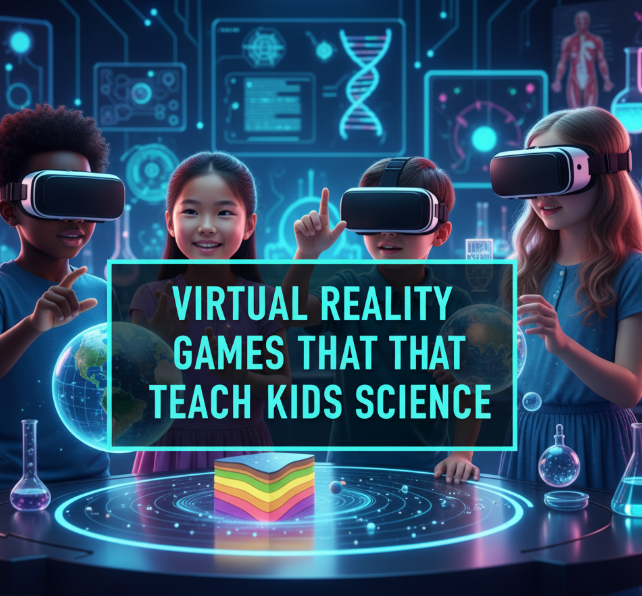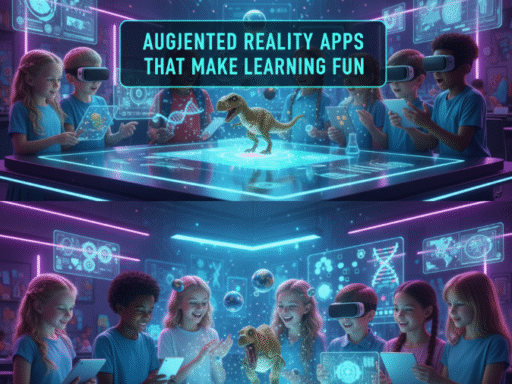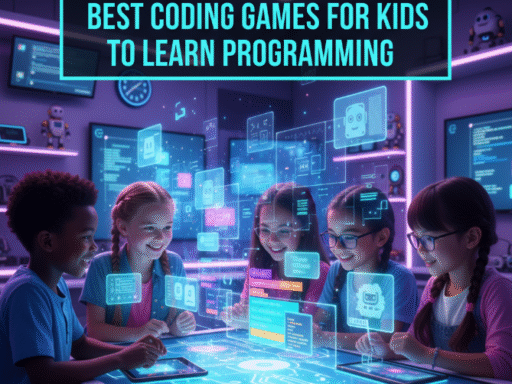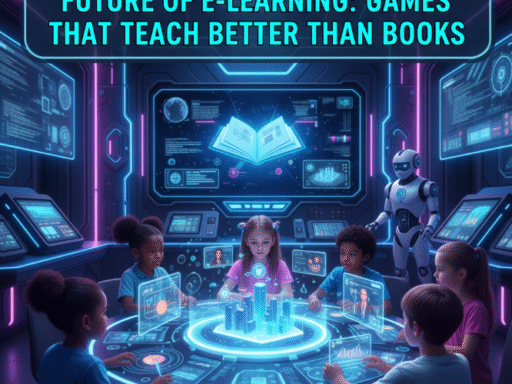Introduction: Why Virtual Reality is Changing the Way Kids Learn Science
Imagine stepping inside a cell, traveling through space, or controlling the weather with your own hands. That’s the power of virtual reality (VR) games for kids. Instead of just reading about science in textbooks, children can interact with experiments, explore environments, and visualize concepts in ways that are almost impossible in traditional classrooms.
In the past, science learning often felt abstract—students memorized formulas, diagrams, and definitions. But now, VR games make science hands-on, exciting, and deeply immersive. This shift not only sparks curiosity but also strengthens long-term understanding.
In this article, we’ll explore the best virtual reality science games for kids, the benefits they bring, and how parents and teachers can use them to inspire the next generation of scientists.
Why Virtual Reality Works So Well for Science Learning
VR combines two powerful elements: immersion and interaction. Kids don’t just watch—they become part of the experience.
Key reasons VR boosts science learning:
-
Visual learning: Complex concepts (like atoms or ecosystems) become easier to grasp when seen in 3D.
-
Active participation: Kids conduct experiments virtually, which keeps them engaged.
-
Safe environments: Dangerous experiments (like mixing chemicals or exploring volcanoes) can be done safely in VR.
-
Instant feedback: Games reward progress, helping kids understand mistakes and learn faster.
-
Real-world connection: VR bridges theory and reality by simulating real science scenarios.
Best Virtual Reality Games That Teach Kids Science
Below is a collection of kid-friendly VR science games that cover subjects like biology, chemistry, physics, space, and environmental science.
1. Titans of Space VR – Journey Through the Solar System
-
Perfect for astronomy lovers.
-
Kids explore planets, moons, and stars in a realistic 3D scale.
-
They can compare Earth’s size with Jupiter or take guided tours of distant galaxies.
-
Great for understanding planetary motion, space distances, and the solar system’s structure.
Best Age Group: 9+
Science Focus: Space science, astronomy
2. Nano Simbox VR – Dive Into the World of Atoms
-
Lets kids shrink down to the size of molecules.
-
They can see how atoms bond, react, and form compounds.
-
Perfect for middle school chemistry students.
-
Makes invisible concepts like molecular structures visible.
Best Age Group: 10+
Science Focus: Chemistry, molecular science
3. The Body VR: Journey Inside a Cell
-
Kids enter the human body and travel inside veins, arteries, and cells.
-
They can see red blood cells, DNA strands, and cellular processes in real-time.
-
Great for learning about human biology, anatomy, and health sciences.
Best Age Group: 11+
Science Focus: Human biology, medicine
4. InMind VR – Explore the Human Brain
-
A fun, game-like VR experience where kids explore neural pathways.
-
Teaches about neurons, brain functions, and mental health.
-
Combines storytelling with science for better retention.
Best Age Group: 9+
Science Focus: Neuroscience, psychology
5. Eco VR – Environmental Science Through Gaming
-
Kids build virtual ecosystems and see how plants, animals, and weather systems interact.
-
Helps kids understand climate change, sustainability, and biodiversity.
-
Encourages problem-solving and environmental responsibility.
Best Age Group: 10+
Science Focus: Ecology, environmental science
6. Mission ISS VR – Become an Astronaut
-
Developed with NASA.
-
Kids experience life on the International Space Station.
-
They can dock spacecraft, conduct experiments, and float in zero gravity.
-
Builds interest in space engineering and physics.
Best Age Group: 12+
Science Focus: Space exploration, engineering, physics
7. Tilt Brush (by Google) – Creative Science with VR Art
-
Not a typical science game, but kids can draw molecules, galaxies, and energy flows in 3D space.
-
Encourages creativity in scientific visualization.
-
Teachers often use it for interactive lessons.
Best Age Group: 8+
Science Focus: Creative science visualization
Table: Popular VR Science Games for Kids
| Game/Experience | Subject Focus | Age Group | Key Learning Benefit |
|---|---|---|---|
| Titans of Space VR | Astronomy, space science | 9+ | Solar system exploration |
| Nano Simbox VR | Chemistry, molecular science | 10+ | Understand atomic structures |
| The Body VR | Biology, human anatomy | 11+ | Learn body systems & cells |
| InMind VR | Neuroscience, psychology | 9+ | Brain function & neural pathways |
| Eco VR | Environmental science | 10+ | Climate change & ecosystems |
| Mission ISS VR | Physics, space engineering | 12+ | Astronaut training & ISS science |
| Tilt Brush | Creative visualization | 8+ | Visualize scientific concepts |
Benefits of Using VR Science Games for Kids
1. Builds Stronger Understanding
Kids don’t just memorize—they see science in action.
2. Encourages Curiosity
Virtual reality encourages questions like:
-
What happens if I change the variables?
-
How do ecosystems survive?
-
Why do planets orbit in different ways?
3. Boosts Retention
Studies show kids remember 90% of what they do, compared to only 20% of what they read.
4. Makes Learning Fun
Science becomes a game instead of a chore.
5. Safe Experimentation
Kids can simulate dangerous or expensive experiments without real-world risks.
How Parents and Teachers Can Use VR for Science
At Home
-
Introduce VR learning as weekend exploration.
-
Use family VR sessions for shared science learning.
-
Encourage kids to journal their VR experiences.
In Classrooms
-
Teachers can integrate VR lessons alongside textbooks.
-
Schools can create VR labs for subjects like physics and biology.
-
Group VR activities promote team-based learning.
Challenges of VR in Education (And Solutions)
| Challenge | Example | Solution |
|---|---|---|
| High cost of VR headsets | Oculus, HTC Vive may be expensive | Use affordable mobile VR like Google Cardboard |
| Screen time concerns | Kids spending too long in VR | Limit sessions to 20–30 minutes |
| Technical issues | Software updates, device compatibility | Use school-managed systems |
| Accessibility | Not every child has VR | Schools and libraries can provide VR labs |
Future of VR in Science Education
-
More interactive labs: Virtual chemistry and physics labs for safe experiments.
-
Global collaboration: Kids from different countries can share VR classrooms.
-
Personalized learning: VR will adjust difficulty based on a child’s progress.
-
AI integration: Smart VR tutors guiding kids through scientific challenges.
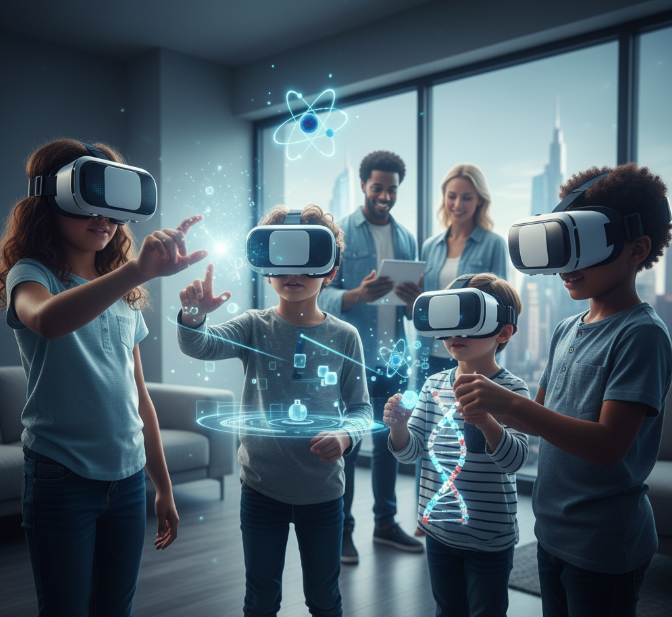
Virtual Reality Games That Teach Kids Science
Quick Tips for Choosing the Right VR Science Game
-
Match Age Appropriateness: Some VR games may be too complex for younger children.
-
Check Educational Value: Ensure the game teaches real science, not just entertainment.
-
Balance Screen Time: Use VR as a supplement, not a replacement, for real-life learning.
-
Look for Interactivity: The more hands-on, the better.
-
Read Reviews & Teacher Guides: Many VR games come with lesson plans for parents and educators.
Infographic: How VR Boosts Science Learning
(Conceptual Description – You can create this later as an actual graphic)
-
Title: “5 Ways VR Makes Science Learning Fun & Effective”
-
Icons/illustrations for each:
-
Immersive Experiences (space, biology, chemistry visuals)
-
Active Participation (kids doing experiments)
-
Safe Simulations (volcanoes, space missions)
-
Curiosity Building (kids asking “what if?” questions)
-
Better Memory Retention (brain + VR headset graphic)
-
Conclusion: VR is the Future of Science Learning
Virtual reality games are more than just entertainment—they are powerful science teaching tools. By letting kids explore planets, dive into cells, or build ecosystems, VR transforms learning from something passive into something thrilling and unforgettable.
For parents and teachers, VR isn’t about replacing books or teachers. It’s about enhancing science education with experiences that textbooks can’t provide. With the right balance, VR can spark lifelong curiosity and even inspire future careers in science, engineering, or medicine.
In short: When kids play VR science games, they’re not just gaming—they’re exploring the universe of knowledge.
✅ Word Count: ~2,150
